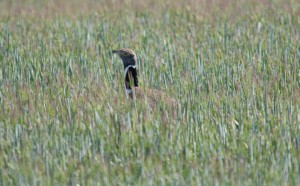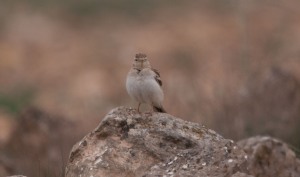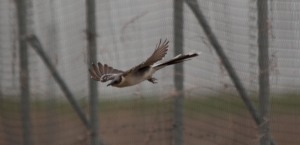Spring quick trip to Los Monegros
Marek mailed me two days before our quick trip started. He and two friends of him were coming to Barcelona to see two football matches. They were expert birders in Poland so as they had two days in Barcelona they wanted to enjoy some birding.

They asked me for watch most of the steppe specialities in one day and a half as they wanted to be back in Barcelona at two o’clock in our second day. In the list was Pint-tailed Sandgrouse, Black-bellied Sandgrouse, Little Bustard, Thekla Lark, Dupont’s Lark, Calandra Lark, Lesser Short-toed Lark, Black Wheatear and Spectacled Warbler.
As they had their own car I offered them a special price so I joined them in their hotel at 6:30am on April 22th. After a quick breakfast we arrived to our first location, a gorgeous area with extensive corn fields and mild garriga slopes few kilometers North of Tàrrega. Just two minutes after arriving we found our first Little Bustard (Tetrax tetrax). A magnificient male singing fifty metres from our car. It was singing for the next half-and-hour so my Polish costumers could take nice photos of it. In the same field we located a pair of Red-legged Partridge (Alectoris rufa), 4 Calandra Larks (Melanocorypha calandra) singing and purchasing each other, some Short-toed Larks (Calandrella brachydactyla) and some passage birds as three Winchats (Saxicola rubetra) and some Northern Wheatears (Oenanthe oenanthe).
We spent several minutes with the nice view of that Little Bustard feeding on the open field and singing every five, six minutes. Other males replayed it and more Little Bustards were moving in the fields around as we saw a small flock of four of them flying over the green fields.
In those same farm land there was a pair of Stone Curlew (Burhinus oedicnemus) calling quite nervous as a juvenile Marsh Harrier (Circus aeruginosus) was enjoying a small rodent that had captured some minutes ago. After a so nice start we explored some houses near there. Those buildings are home to Tree Sparrow (Passer montanus), Little Owl (Athene noctua) and Hoopoe (Upupa epops). Nice sight of Iberian Green Woodpecker (Picus viridis sharpei), Western Bonelli’s Wambler (Phylloscopus bonelli), Sardinian Warbler (Sylvia melanocephala) and Black Kite (Milvus migrans) came to complete this first stop.

We came to the car and drove four hundred meters to stop around a nice slopes covered by low Thyme garriga. Those areas are really interesting for Thekla Lark. Just stoped the car we located a 3th year Golden Eagle (Aquila chrysaetos) perched on ground just 80 metres from us! An incredible sight of this magnificient raptor. It was clear that it has won a prey as many Magpies (Pica pica) were trying to disturbed it but the gorgeous bird of prey didn’t move at all nor for them neither for us.
We climp up the slopes to discover at least two different pairs of Thekla Larks (Galerida theklae)singing and moving quite active in those hills. Several Western Bonelli’s Warbler were moving in the area; it was clear it was the passage bird of the day. Those hills still gave us some surprises as we saw a nice Fox (Vulpes vulpes) moving in the fields and raptors as Hobby (Falco subbuteo) -a pair, Red Kite (Milvus milvus), Griffon Vulture (Gyps fulvus) -4 of them, Common Kestrel (Falco tinnunculus) and Short-toed Eagle (Circaetus gallicus).
It was already 11 o’clock in the morning. We came back to the car and drove to Los Monegros. Before to re-start our birding activities we decided to have lunch in a mid-way town; Fraga. At two o’clock we were about to visit some clay cliffs South to Fraga where we found Rock Bunting (Emberiza cia), Crag Martin (Ptynoprogne rupestris), Common Kestrel (Falco tinnunculus), Jackdaw (Corvus monedula), Alpine Swift (Apus melba) and the elusive Black Wheatear (Oenanthe leucura). Moreover the riberines beside the cliffs gave us nice sights of Short-toed Treecreper (Certhia brachydactyla), Pied – (Ficedula hypoleucos) & Spotted Flycatchers (Muscicapa striata), Little Ringed Plover (Charadius dubius), Common Sandpiper (Actitis hypoleucos) and White Stork (Ciconia ciconia) while in the fields around we found out some Bee-eaters (Merops apiaster), Black-eared Wheatears (Oenanthe hispanica) as well as a pair Iberian Grey Shrike (Lanius meridionalis) -nesting in the same valley since 2009- and Ortolan (Emberiza hortulana).

After this succesful area we moved near Ballobar to explore a some nice areas for steppe birds. We first went to find Spectacled Warbler (Sylvia conspicillata) and we found a nice pair moving around a pool in the middle of the steppes. Some Tawny Pipit (Anthus campestris) were also moving in the area. Then we visited some nice areas for Pin-tailed Sandgrouse (Pterocles alchata). We got incredible sights of them, two pairs moving less than eighty metres from us!!! We enjoyed that sight for a couple of minutes and then we left the area surrounded by several Greater Short-toed- & Calandra Larks. It was five o’clock and then we found an incredible pair of Great Spotted Cuckoo (Clamator glandarius) just moving on the steppes. This is typical place for them, coming back year after year at this same point. But this time they were really calm and we could watch them for over ten minutes and we had the chance to watch them in a copula!!!
It was already six o’clock. We took a short break for a drink and I told them to leave Black-bellied Sandgrouse for next morning as it will be better so we went to a nice area for Lesser Kestrel (Falco naumannii). We saw several pairs moving around their colony. At the same time we got nice views of Chough (Phyrrocorax phyrrocorax) while two Little Bustards were singing and well visibles in the fields. Those fields are also nice for Rollers but it was clear they were not yet in the area.
At seven-and-a-half we arrived to our hotel in Castejón de Monegros. A perfect rest in Casa Rural La Madre after an intense birding day. We started April 23th at 7:00 am. Just beside our hotel there are some Rock Sparrows (Petronia petronia) nesting in a half destroyed house. We got nice views of them and inmediatly moved to some incredible open fields where Black-bellied Sandgrouses (Pterocles orientalis) likes to move around. Just two minutes after arriving there we found some pairs feeding on them. We enjoyed for several minutes, in this time we also located Golden Oriole (Oriolus oriolus), Calandra Larks and Lesser Short-toed Lark (Calandrella rufescens).

Later we went to explore around the village of Monegrillo. A pair of Booted Eagle (Hieraaetus pennatus) use to go there for hunt. We easily found one of them and some other raptors including Golden Eagle, Griffon Vulture, Red Kite, Black Kite and Marsh Harrier. After take some breakfast we decided to visit some wetlands, the wind was getting stronger so we decided to refuge inside a hide. Many waders were moving in the area, a quick view allowed us to discover Kentish Plover (Charadrius alexandrinus), Greenshank (Tringa nebularia), Spotted Redshank (Tringa erythropus), Redshank (Tringa totanus), Ruff (Phylomachus pugnax), Little Stint (Calidris minuta), Dunlin (Calidris alpina), Black-winged Stilt (Himantopus himantopus) and Little Ringed Plover and also Yellow Wagtail (Motacilla flava), Meadow Pipit (Anthus pratensis) and Common Whitethroat (Sylvia communis).
It was too windy to spend more time in the steppes. We decided to move back to Barcelona to avoid the wind and spend some more time trying to locate some intesting species. We arrived to Llobregat Delta at 13:00 pm; Mediterranean Gull (Larus melanocephalus), Audouin’s Gull (Larus audounii), Cetti’s Warbler (Cettia cetti), Gull-billed Tern (Gelochelidon nilotica), Shelduck (Tadorna tadorna), Greenshank, Little Stint and Cattle Egret (Bubulcus ibis) were the more interesting species before my costumers decided to come back to Barcelona.
It was a great birding break reporting 119 species of birds !!!!

